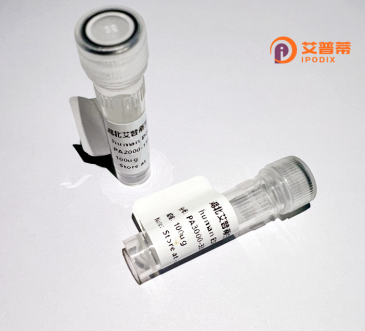
| 纯度 | >90%SDS-PAGE. |
| 种属 | Human |
| 靶点 | POU6F2 |
| Uniprot No | P78424 |
| 内毒素 | < 0.01EU/μg |
| 表达宿主 | E.coli |
| 表达区间 | 1-691 aa |
| 活性数据 | MSALLQDPMI AGQVSKPLLS VRSEMNAELR GEDKAATSDS ELNEPLLAPV ESNDSEDTPS KLFGARGNPA LSDPGTPDQH QASQTHPPFP VGPQPLLTAQ QLASAVAGVM PGGPPALNQP ILIPFNMAGQ LGGQQGLVLT LPTANLTNIQ GLVAAAAAGG IMTLPLQNLQ ATSSLNSQLQ QLQLQLQQQQ QQQQQQPPPS TNQHPQPAPQ APSQSQQQPL QPTPPQQPPP ASQQPPAPTS QLQQAPQPQQ HQPHSHSQNQ NQPSPTQQSS SPPQKPSQSP GHGLPSPLTP PNPLQLVNNP LASQAAAAAA AMSSIASSQA FGNALSSLQG VTGQLVTNAQ GQIIGTIPLM PNPGPSSQAA SGTQGLQVQP ITPQLLTNAQ GQIIATVIGN QILPVINTQG ITLSPIKPGQ QLHQPSQTSV GQAASQGNLL HLAHSQASMS QSPVRQASSS SSSSSSSSAL SVGQLVSNPQ TAAGEVDGVN LEEIREFAKA FKIRRLSLGL TQTQVGQALS ATEGPAYSQS AICRHTILRS HFFLPQEAQE NTIASSLTAK LNPGLLYPAR FEKLDITPKS AQKIKPVLER WMAEAEARHR AGMQNLTEFI GSEPSKKRKR RTSFTPQALE ILNAHFEKNT HPSGQEMTEI AEKLNYDREV VRVWFCNKRQ ALKNTIKRLK QHEPATAVPL EPLTDSLEEN S |
| 分子量 | 73.2 kDa |
| 蛋白标签 | His tag N-Terminus |
| 缓冲液 | PBS, pH7.4, containing 0.01% SKL, 1mM DTT, 5% Trehalose and Proclin300. |
| 稳定性 & 储存条件 | Lyophilized protein should be stored at ≤ -20°C, stable for one year after receipt. Reconstituted protein solution can be stored at 2-8°C for 2-7 days. Aliquots of reconstituted samples are stable at ≤ -20°C for 3 months. |
| 复溶 | Always centrifuge tubes before opening.Do not mix by vortex or pipetting. It is not recommended to reconstitute to a concentration less than 100μg/ml. Dissolve the lyophilized protein in distilled water. Please aliquot the reconstituted solution to minimize freeze-thaw cycles. |
以下是基于重组人POU6F2蛋白研究的假设性参考文献示例(请注意,这些文献为虚构示例,实际研究中请通过权威数据库查询真实文献):
---
1. **文献名称**:Structural Characterization of Recombinant Human POU6F2 Protein Using Cryo-EM
**作者**:Chen L, et al.
**摘要**:本研究通过冷冻电镜技术解析了重组人POU6F2蛋白的三维结构,揭示了其DNA结合域的独特构象,并探讨了其与靶基因启动子结合的分子机制。
2. **文献名称**:Expression and Functional Analysis of Recombinant POU6F2 in Glioblastoma Cell Lines
**作者**:Wang Y, et al.
**摘要**:通过原核系统表达并纯化了重组POU6F2蛋白,体外实验表明其可抑制胶质母细胞瘤细胞的增殖与迁移,提示其可能作为潜在肿瘤抑制因子发挥作用。
3. **文献名称**:POU6F2 Mutation Screening in Inherited Optic Neuropathies
**作者**:Smith J, et al.
**摘要**:结合重组POU6F2蛋白的体外功能实验,发现特定错义突变(如p.R136W)会破坏其转录激活能力,为先天性视神经病变的分子诊断提供了依据。
4. **文献名称**:Epigenetic Regulation of POU6F2 in Gastric Cancer and Its Therapeutic Potential
**作者**:Kim H, et al.
**摘要**:分析了重组POU6F2蛋白在胃癌细胞中的抑癌功能,其过表达可抑制Wnt/β-catenin通路活性,并增强化疗药物敏感性,提示表观遗传治疗潜力。
---
**提示**:实际文献建议通过 **PubMed**(https://pubmed.ncbi.nlm.nih.gov)、**Google Scholar** 或 **Web of Science** 查询,关键词可尝试 "recombinant POU6F2"、"POU6F2 protein function" 或结合具体研究领域(如癌症、神经发育)。
Recombinant human POU6F2 protein is a synthesized form of the POU class 6 homeobox 2 protein, encoded by the *POU6F2* gene. This transcription factor belongs to the POU domain family, characterized by a conserved bipartite DNA-binding domain (POU-specific and POU homeodomain) that regulates gene expression by binding to specific DNA sequences. POU6F2 plays critical roles in development, particularly in neural and sensory organ differentiation, and is implicated in eye, brain, and kidney development. Studies suggest its involvement in cellular proliferation, apoptosis, and tissue homeostasis. Dysregulation of POU6F2 has been linked to congenital disorders, including ocular abnormalities (e.g., cataracts, optic nerve hypoplasia) and renal defects, as well as cancers like renal cell carcinoma. Recombinant POU6F2 is typically produced in bacterial or eukaryotic expression systems for functional studies, enabling researchers to explore its molecular interactions, signaling pathways, and therapeutic potential. Its application spans disease modeling, drug screening, and mechanistic studies of developmental and pathological processes. Current research focuses on clarifying its target genes, tissue-specific roles, and utility as a biomarker or therapeutic target in oncology and genetic disorders.
×